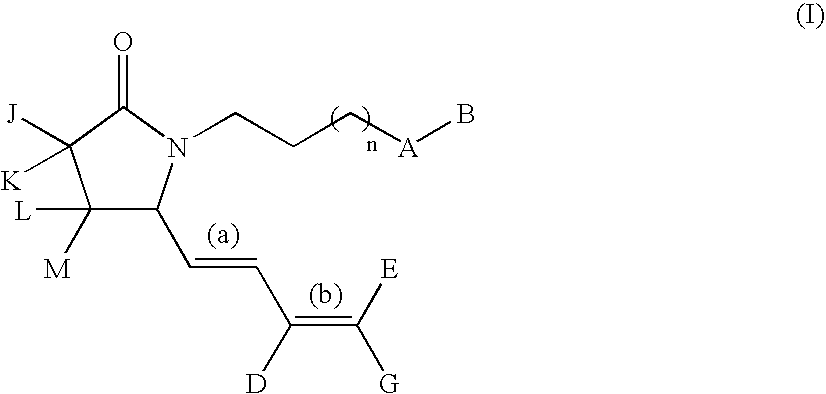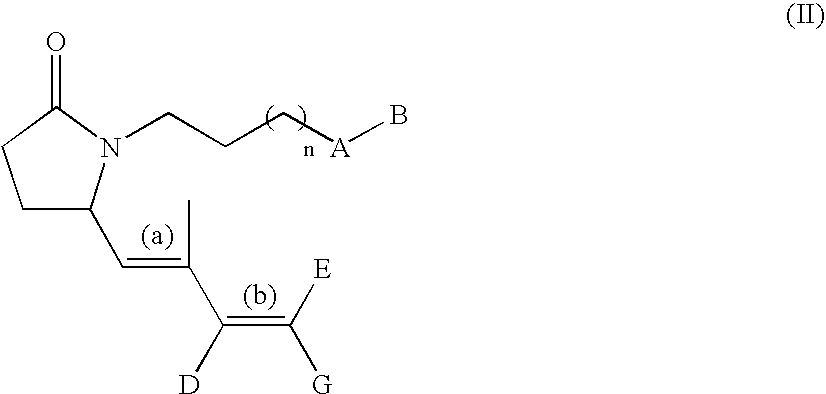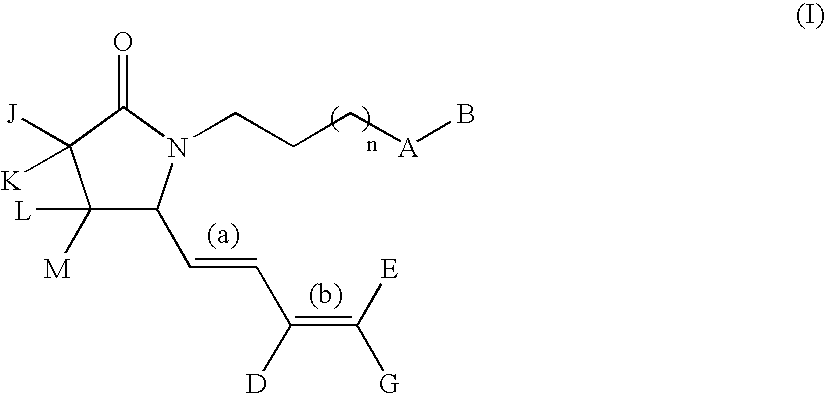G-lactam derivatives as prostaglandin agonists
a technology of prostaglandins and derivatives, which is applied in the field of g-lactam derivatives, can solve the problem that the endogenous prostaglandin cannot achieve the selective effect of one of the sub-types of the bp receptor, and achieve the effect of reducing the number of side effects
- Summary
- Abstract
- Description
- Claims
- Application Information
AI Technical Summary
Benefits of technology
Problems solved by technology
Method used
Image
Examples
example 1 and 2
Synthesis of 4-(2-{(2R)-2-[(1Z,3E)-octa-1,3-dienyl]-5-oxopyrrolidin-1-yl}ethyl)benzoic acid and 4-(2-{(2R)-2-[(1E,3E)-octa-1,3-dienyl]-5-oxopyrrolidin-1-yl}ethyl)benzoic acid
[0212]
Intermediate 1.1: tert-butyl 1-{2-[4-(methoxycarbonyl)phenyl]ethyl}-5-oxo-D-prolinate (Scheme 1)
[0213] To a solution of H-D-Glu(OtBu)-OtBu, commercially available from Bache (0.5 g, 2.23 mmol) in MeOH (15 mL) were added 4-carbomethoxyphenylacetaldehyde (obtained from methyl 4-formyl benzoate as described in Nair et al., 1989) (0.4 g, 2.23 mmol), acetic acid (0.15 mL, 2.67 mmol), and NaCNBH3 (3.3 mL, 1.0 M THF solution, 3.3 mmol). The resulting solution was stirred at RT for 3 h then was diluted with EtOAc (100 mL) and washed with water (50 mL), and brine (50 mL). The organic solution was dried over sodium sulfate and concentrated in vacuo. The crude oil was diluted with xylene and the solution refluxed for 5 h. This solution was concentrated under reduced pressure and purified by silica gel column chroma...
examples 1 and 2
[0218] To a solution of intermediate 1.5 (80 mg, 0.225 mmol) in MeOH (6 mL) and water (0.2 mL) was added NaOH (20 mg, 0.5 mmol). The resulting solution was heated under microwave oven for 15 min at 80° C. in a sealed tube. Then the reaction mixture was concentrated under reduced pressure. The crude mixture of diastereomers was purified by RP-HPLC using ACN / H2O 0.1% TFA to afford the desired compounds.
example 1
[0219] (First isomer in HPLC: ACN / H2O / TFA, 44 mg): 1H NMR (CDCl3): δ 0.90 (two t), 1.2-1.5 (m), 1.58-1.80 (m), 2.0-2.5 (m), 2.70-3.0 (m), 3.04-3.26 (m), 3.58-3.80 (m), 3.94-4.08 (m, 1H), 4.4-4.64 (m) 5.20 (t, J=10.25 Hz) 5.35 (dd, J1=15.01 Hz, J2=9.15 Hz, 1H), 5.51 (dd, J1=15.0 Hz, J2=7.69 Hz, 1H), 5.8 (m), 5.97 (t, J=10.98, 1H), 6.13-6.25 (m), 6.4-6.59 (m) 7.28 (two d, 4H), 7.92 (two d, 4H); 13C NMR (CDCl3): 14.6, 23.5, 26.9, 27.0, 28.2, 28.6, 31.2, 31.3, 32.7, 32.9, 33.0, 33.7, 34.7, 43.2, 56.8, 57.3, 63.1, 122.7, 124.9, 127.5, 127.7, 129.4, 129.9, 130.4, 132.0, 133.6, 134.3, 136.0, 139.1, 145.2, 168.6, 176.5; MS calculated. for C21H27NO3: 341; Found (m / z): 342 (m+1)
PUM
| Property | Measurement | Unit |
|---|---|---|
| diameter | aaaaa | aaaaa |
| mean diameter | aaaaa | aaaaa |
| temperature | aaaaa | aaaaa |
Abstract
Description
Claims
Application Information
 Login to View More
Login to View More - R&D
- Intellectual Property
- Life Sciences
- Materials
- Tech Scout
- Unparalleled Data Quality
- Higher Quality Content
- 60% Fewer Hallucinations
Browse by: Latest US Patents, China's latest patents, Technical Efficacy Thesaurus, Application Domain, Technology Topic, Popular Technical Reports.
© 2025 PatSnap. All rights reserved.Legal|Privacy policy|Modern Slavery Act Transparency Statement|Sitemap|About US| Contact US: help@patsnap.com



